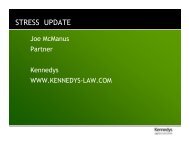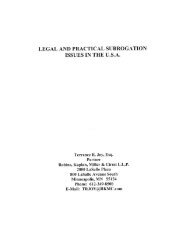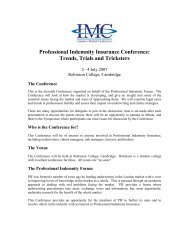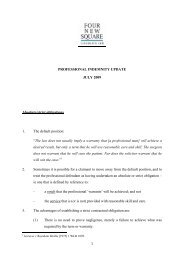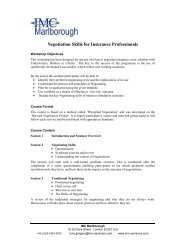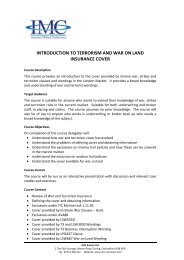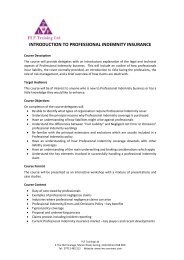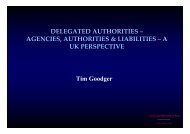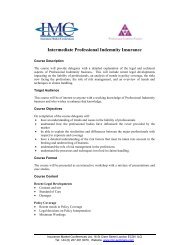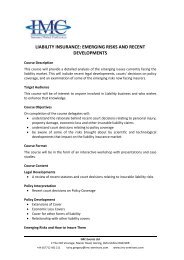Practical Issues in Claims Management - Insurance Market ...
Practical Issues in Claims Management - Insurance Market ...
Practical Issues in Claims Management - Insurance Market ...
Create successful ePaper yourself
Turn your PDF publications into a flip-book with our unique Google optimized e-Paper software.
2004
2005
Lloyd’s <strong>Claims</strong> <strong>Management</strong> Pr<strong>in</strong>ciples& M<strong>in</strong>imum Standards• Came <strong>in</strong>to force 1 st July 2005, with a 6 month transitionperiod• Applied to all Lloyd’s market <strong>in</strong>ward claims and related to theactivities of all manag<strong>in</strong>g agencies’ claims teams work<strong>in</strong>gwith<strong>in</strong> the Lloyd’s market, whether claims handled <strong>in</strong> houseor outsourced.• Franchisor’s claims team to visit all manag<strong>in</strong>g agencies tocommence a process of review.
Lloyd’s <strong>Claims</strong> <strong>Management</strong> Pr<strong>in</strong>ciples1. The claims philosophy should be clearly documented and communicated with<strong>in</strong>the syndicate, and reflected <strong>in</strong> the management and organisation2. Manag<strong>in</strong>g agents should have appropriate claims resources, skills andmanagement controls <strong>in</strong> each l<strong>in</strong>e of bus<strong>in</strong>ess they propose to write3. <strong>Claims</strong> should be adjusted and processed <strong>in</strong> an efficient and timely manner4. The handl<strong>in</strong>g of a claim should be appropriately documented and <strong>in</strong>formationrelevant to the management of the claim reta<strong>in</strong>ed for a reasonable period5. Claim reserv<strong>in</strong>g should be undertaken with the goal of a consistent, timely andaccurate result6. Discipl<strong>in</strong>ed procurement and pro-active management procedures should beemployed <strong>in</strong> the selection and use of third parties7. Measurement of claims management performance and capabilities should beappropriate and regular8. For subscription bus<strong>in</strong>ess there should be an effective claims agreementprocess to protect the <strong>in</strong>terests of followers, supported by full co-operation oflead underwriters(The Pr<strong>in</strong>ciples 5, 6 & 7 were <strong>in</strong>troduced gradually <strong>in</strong> 2005)
2006
Lloyd’s <strong>Claims</strong> Schemes• 1994• 1999• 1999 (Amended) which was <strong>in</strong> effect from 1 July 2005 to1 April 2006 as an <strong>in</strong>terim measure• 2006– Amended to satisfy external regulatory requirements toratify an enhanced <strong>Claims</strong> Agreement for Followers(‘CAF’) service and to reflect market practices– Key change was to largely abolish ‘leader only’contracts. All claims subject to 2006 Scheme must beagreed by a Lead<strong>in</strong>g Lloyd’s underwriter on their ownbehalf and XCS on behalf of all other Lloyd’s syndicates
ECF• LMP 2001 set out a London market wide approach toreform of paper <strong>in</strong>tensive claims process. Vision ofimprov<strong>in</strong>g claims processes to– Provide superior claims service to the ultimate client– Offer rapid decision mak<strong>in</strong>g process• ECF <strong>in</strong>itiative commenced 2004• Infrastructure delivered for use <strong>in</strong> 2006 and significantLloyd’s take up commenced 2007 once mandated• IUA engaged and company market went live January 2008• Electronic claim file is the comb<strong>in</strong>ation of the Insurers<strong>Market</strong> Repository (IMR) and CLASS
ECF 2Development of the <strong>in</strong>frastructure has led to ECF2, whichbr<strong>in</strong>gs• A searchable document viewer, provid<strong>in</strong>g a method ofview<strong>in</strong>g a file as a whole (like a paper file) <strong>in</strong>stead of as aseries of separate documents.• Third Party Access for solicitors and loss adjusters• Streaml<strong>in</strong>ed and more precise claims agreement screens• <strong>Claims</strong> workflow triggers allow<strong>in</strong>g real time updates every 15m<strong>in</strong>utes
2010
<strong>Claims</strong> Transformation Project• Development of a new vision for claims handl<strong>in</strong>g• Aim to enhance Lloyd’s reputation for fair and fast claimhandl<strong>in</strong>g• Improve customer experience through provision of efficient andeffective claim process• CTP <strong>in</strong>troduces– Enhanced segmentation of claims– <strong>Claims</strong> identified as standard (£0-100,000)mid tranche (£0 - £5m)complex (> £5m)– S<strong>in</strong>gle party claims agreement for the majority of high volumelow value claims– Lead plus second claims agreement party <strong>in</strong> high value orcomplex claims– Choice for manag<strong>in</strong>g agents to either <strong>in</strong> source or outsourcetheir role as a claims agreement party
<strong>Claims</strong> Transformation Project cont’d– A mechanism to allow followers to participate more effectively <strong>in</strong> highvalue or complex claims by request<strong>in</strong>g a market meet<strong>in</strong>g if 50% ormore of them wish to do so– The lead and second underwriter both have a duty of care to thefollowers subject to a limit of liability set at £2m each and every claim,capped at £10m <strong>in</strong> the aggregate per manag<strong>in</strong>g agency per year• Lloyd’s role will be enhanced, both for pilot governance and to ensurethat manag<strong>in</strong>g agents have the required claims capabilities to fulfil leadand second roles
2010 Pilot <strong>Claims</strong> Scheme• CTP is currently <strong>in</strong> a pilot phase• First phase of the pilot covered claims on contracts<strong>in</strong>cept<strong>in</strong>g after 1 January 2010 <strong>in</strong> all risk codes <strong>in</strong>follow<strong>in</strong>g classes– Mar<strong>in</strong>e– Property Direct and Facultative– Casualty Treaty• ECF claims only• B<strong>in</strong>ders excluded• Pilot classes expanded with effect from 1 st July thisyear but no formal plans as yet to br<strong>in</strong>g <strong>in</strong> PI classes• Pilot rules be<strong>in</strong>g reviewed – mid tranche may disappearfrom 1 st January 2012
2011
Lloyd’s <strong>Claims</strong> <strong>Management</strong> Pr<strong>in</strong>ciples &M<strong>in</strong>imum Standards• As part of Lloyd’s work on Enhanced Governance, and to be compatiblewith Solvency II requirements, revised <strong>Claims</strong> <strong>Management</strong> Pr<strong>in</strong>ciplesand M<strong>in</strong>imum Standards issued 31 st March 2011• Adherence to the M<strong>in</strong>imum Standards to be assessed by Performance<strong>Management</strong> Directorate by reference to a set of evaluation guidel<strong>in</strong>esstill under discussion• Effective 1 st January 2012 with a 6 month transitional period• <strong>Management</strong> Pr<strong>in</strong>ciples only slightly tweaked• However, M<strong>in</strong>imum Standards amended considerably. While someamendments do not change the substance of the standards, <strong>in</strong> a numberof <strong>in</strong>stances the amendments reflect more detailed requirements• Greater responsibilities of Lloyd’s leader <strong>in</strong> claim management under CTPmeans the Performance <strong>Management</strong> Directorate will be assess<strong>in</strong>gaga<strong>in</strong>st their ability to refuse to allow a manag<strong>in</strong>g agent to act as aleader
Lloyd’s <strong>Claims</strong> <strong>Management</strong> Pr<strong>in</strong>ciples1. The claims philosophy should be clearly documented and communicated with<strong>in</strong> thesyndicate, and reflected <strong>in</strong> the management and organisation• The claims philosophy should be clearly documented with<strong>in</strong> the manag<strong>in</strong>gagent and reflected <strong>in</strong> the management and organisation of the bus<strong>in</strong>ess.2. Manag<strong>in</strong>g agents should have appropriate claims resources, skills and managementcontrols <strong>in</strong> each l<strong>in</strong>e of bus<strong>in</strong>ess they propose to writeManag<strong>in</strong>g agents should have appropriate claims resources, skills andmanagement controls <strong>in</strong> each class of bus<strong>in</strong>ess written or proposed to bewritten.3. <strong>Claims</strong> should be adjusted and processed <strong>in</strong> an efficient and timely manner<strong>Claims</strong> should be adjusted and processed <strong>in</strong> an accurate and professionalmanner and properly managed to conclusion, hav<strong>in</strong>g regard to thecircumstances of the claim.4. The handl<strong>in</strong>g of a claim should be appropriately documented and <strong>in</strong>formation relevant tothe management of the claim reta<strong>in</strong>ed for a reasonable periodThe handl<strong>in</strong>g of a claim should be appropriately documented and <strong>in</strong>formationrelevant to the management of the claim reta<strong>in</strong>ed for an appropriate period
5. Claim reserv<strong>in</strong>g should be undertaken with the goal of a consistent, timely andaccurate resultClaim reserv<strong>in</strong>g should be undertaken with the goal of a consistent,timely and accurate result and should take <strong>in</strong>to account both possiblecosts and <strong>in</strong>demnity potential6. Discipl<strong>in</strong>ed procurement and pro-active management procedures should beemployed <strong>in</strong> the selection and use of third partiesDiscipl<strong>in</strong>ed procurement and pro-active management proceduresshould be employed <strong>in</strong> the selection and use of third parties7. Measurement of claims management performance and capabilities should beappropriate and regularPlann<strong>in</strong>g, measurement and review of claims managementperformance and capabilities should be appropriate and regular8. For subscription bus<strong>in</strong>ess there should be an effective claims agreementprocess to protect the <strong>in</strong>terests of followers, supported by full co-operation oflead underwritersFor subscription bus<strong>in</strong>ess there should be an effective claimsagreement process to protect the <strong>in</strong>terests of followers, supported byco-operation of claims agreement parties
M<strong>in</strong>imum Standards
<strong>Claims</strong> PhilosophyPr<strong>in</strong>cipleThe claims philosophy should be clearly documented and communicated with<strong>in</strong> themanag<strong>in</strong>g agent, and reflected <strong>in</strong> the management and organisation of the bus<strong>in</strong>ess.M<strong>in</strong>imum standardsa) The manag<strong>in</strong>g agent’s philosophy <strong>in</strong>cludes documented executive and boardcommitment to, and oversight of, an effective claims management process. This will<strong>in</strong>clude commitment, where needed, to fulfill<strong>in</strong>g responsibilities to followers.b) The philosophy will <strong>in</strong>clude board commitment to adjust and manage claims on themerits to meet or exceed Lloyd’s <strong>Claims</strong> <strong>Management</strong> Pr<strong>in</strong>ciples and M<strong>in</strong>imum Standards.c) Each syndicate bus<strong>in</strong>ess plan* proposed by a manag<strong>in</strong>g agent addresses themanagement of claims, <strong>in</strong>clud<strong>in</strong>g the sett<strong>in</strong>g of claims related objectives and targets.d) A director of the manag<strong>in</strong>g agent has board responsibility for effective claimsmanagement.e) The manag<strong>in</strong>g agent’s board regularly considers the efficiency and effectiveness of theclaims management process us<strong>in</strong>g appropriate management <strong>in</strong>formation.f) There is executive and board commitment to ensur<strong>in</strong>g that claims <strong>in</strong>formation andknowledge is available for, and used <strong>in</strong>, bus<strong>in</strong>ess plann<strong>in</strong>g and decisions. The manag<strong>in</strong>gagent’s organisational structure facilitates this process.g) The manag<strong>in</strong>g agent’s philosophy relat<strong>in</strong>g to the management of claims is documentedand communicated to staff whose jobs <strong>in</strong>volve or relate from time to time to claimshandl<strong>in</strong>g, reserv<strong>in</strong>g or underwrit<strong>in</strong>g.
Resources, skills and managementcontrolsPr<strong>in</strong>cipleManag<strong>in</strong>g agents should have appropriate claims resources, skills and managementcontrols <strong>in</strong> each class of bus<strong>in</strong>ess written or proposed to be written.M<strong>in</strong>imum standardsa) There is appropriate claims resourc<strong>in</strong>g, structure and succession plann<strong>in</strong>g for the classesof bus<strong>in</strong>ess written and adequate plann<strong>in</strong>g and resourc<strong>in</strong>g to address bus<strong>in</strong>essdevelopment. Skills gaps and resourc<strong>in</strong>g needs are identified and addressed <strong>in</strong> a timelymanner as appropriate to the circumstances.b) Required skills have been identified and are be<strong>in</strong>g developed and supported viaappropriate tra<strong>in</strong><strong>in</strong>g and development processes, which <strong>in</strong>clude consideration of changes<strong>in</strong> the legal and regulatory environment. There are job descriptions for each role.c) <strong>Claims</strong> staff have documented authorisation levels for settlement and reserv<strong>in</strong>gappropriate to the type of claim, their experience, and skills. Individual authority levelsare reviewed at least annually and adjusted as circumstances require for efficient andeffective claims management.d) There is appropriate separation, at the operational level, of underwrit<strong>in</strong>g and claimsauthority/duties to manage potential conflicts of <strong>in</strong>terest.e) Identified performance criteria for <strong>in</strong>dividuals are <strong>in</strong> use and are expla<strong>in</strong>ed to staff. Thesecriteria are l<strong>in</strong>ked to the objectives of the annual claims bus<strong>in</strong>ess plan*.
Resources, skills and management controlscont’df) There is a structured process of annual performance review, used for the plann<strong>in</strong>g andreview of learn<strong>in</strong>g and development and the management of performance.g) The board ensures that sufficient management controls and audits (<strong>in</strong>ternal and external)are used to evaluate claims performance* and where matters are identified as requir<strong>in</strong>gattention, they are addressed.h) There is an appropriately detailed, regular file review process, the basis of which isdocumented, and the results of which reviewed with the relevant claims handler.
<strong>Claims</strong> adjustment and managementPr<strong>in</strong>ciple<strong>Claims</strong> should be adjusted and processed <strong>in</strong> an accurate and professional manner andproperly managed to conclusion, hav<strong>in</strong>g regard to the circumstances of the claim.M<strong>in</strong>imum standardsManag<strong>in</strong>g agents:a) Follow<strong>in</strong>g notice and dur<strong>in</strong>g the life of claims, assess what actions can be taken to resolveclaims on the merits and <strong>in</strong> reasonable time frames hav<strong>in</strong>g regard to the circumstances.b) Ma<strong>in</strong>ta<strong>in</strong> processes and procedures for the management of claims that are clear,documented and shared with relevant personnel as needed to ensure effectivemanagement of claims. †c) Provide an appropriate level of service to brokers or policyholders <strong>in</strong> the circumstances ofthe claim, <strong>in</strong>clud<strong>in</strong>g communication of actions and progress where appropriate.d) Have <strong>in</strong> place an appropriate documented anti-fraud strategy.e) Provide adequate tra<strong>in</strong><strong>in</strong>g and procedures to comply with applicable sanctions and antimoneylaunder<strong>in</strong>g rules. †f) Identify, monitor and pursue, where appropriate, rights of subrogation and salvage.Note: where a manag<strong>in</strong>g agent is act<strong>in</strong>g purely <strong>in</strong> the capacity of a follower, it will benecessary to comply only with those m<strong>in</strong>imum standards marked †.
DocumentationPr<strong>in</strong>cipleThe handl<strong>in</strong>g of a claim should be appropriately documented and <strong>in</strong>formation relevant tothe management of the claim reta<strong>in</strong>ed for an appropriate period.M<strong>in</strong>imum standardsa) Where it is the manag<strong>in</strong>g agent’s responsibility, claims files are ma<strong>in</strong>ta<strong>in</strong>ed <strong>in</strong> such a wayas to ensure that relevant claims <strong>in</strong>formation is available to followers <strong>in</strong> a timely manner.b) An appropriate document retention policy is documented and <strong>in</strong> use, <strong>in</strong>clud<strong>in</strong>g forelectronic <strong>in</strong>formation, tak<strong>in</strong>g <strong>in</strong>to account legal and regulatory requirements.†c) An appropriate and documented procedure for handl<strong>in</strong>g discovery, <strong>in</strong>clud<strong>in</strong>g e-discovery, is<strong>in</strong> use. †Note: where a manag<strong>in</strong>g agent is act<strong>in</strong>g purely <strong>in</strong> the capacity of a follower, it will benecessary to comply only with those m<strong>in</strong>imum standards marked †.
Claim Reserv<strong>in</strong>gPr<strong>in</strong>cipleClaim reserv<strong>in</strong>g should be undertaken with the goal of a consistent, timely andaccurate result and should take <strong>in</strong>to account both possible costs and <strong>in</strong>demnitypotential.M<strong>in</strong>imum standardsa) Manag<strong>in</strong>g agents have a documented reserv<strong>in</strong>g philosophy agreed by the board thatprovides overview guidance for assess<strong>in</strong>g and determ<strong>in</strong><strong>in</strong>g claim reserves* and that ismade available to followers on request.b) Claim reserves* exist without prejudice to coverage and make f<strong>in</strong>ancial provisiontak<strong>in</strong>g <strong>in</strong>to account currently available <strong>in</strong>formation. Manag<strong>in</strong>g agents <strong>in</strong> a claimsagreement role should ensure that the rationale for the current reserve position isavailable to followers.c) Initial reserves are set as soon as practicable follow<strong>in</strong>g first advice.d) Matters where further <strong>in</strong>formation is required before an estimate of reserve may bemade are reviewed regularly.e) Manag<strong>in</strong>g agents take reasonable steps to obta<strong>in</strong> <strong>in</strong>formation to enable a reserve tobe established and for it to be ma<strong>in</strong>ta<strong>in</strong>ed up to date. Reserves on open claims arereassessed promptly upon receipt of relevant additional <strong>in</strong>formation.
Claim Reserv<strong>in</strong>g cont’df) Reserves on open claims are reviewed at least every 12 months, and the reserve normallyeither actively confirmed or amended, as appropriate, based on up to date <strong>in</strong>formation.g) <strong>Claims</strong> agreement parties take reasonable steps to ensure that:i. followers receive, as soon as practicable, the same reserve related <strong>in</strong>formationreceived by those claims agreement parties; andii. followers are alerted to situations where it is appropriate for them to consider<strong>in</strong>dependently the reserve.h) Large reserve entries are validated via an <strong>in</strong>ternal peer review process
<strong>Management</strong> of external service providersPr<strong>in</strong>cipleDiscipl<strong>in</strong>ed procurement and pro-active management procedures should be employed <strong>in</strong>the selection and use of third parties.M<strong>in</strong>imum standardsDelegation of claims authority <strong>in</strong>clud<strong>in</strong>g where claims management is outsourced:a) Manag<strong>in</strong>g agents comply with Lloyd’s and other regulatory requirements <strong>in</strong> relation tooutsourc<strong>in</strong>g.b) <strong>Claims</strong> are handled <strong>in</strong> accordance with Lloyd’s <strong>Claims</strong> <strong>Management</strong> Pr<strong>in</strong>ciples andM<strong>in</strong>imum Standards.c) Manag<strong>in</strong>g agents use a documented process to assess third parties for suitability prior todelegation to them of claims handl<strong>in</strong>g authority.d) Manag<strong>in</strong>g agents determ<strong>in</strong>e the appropriate level of handl<strong>in</strong>g, reserv<strong>in</strong>g and settlementauthority given to the third party <strong>in</strong> respect of each type of claim for which authority isdelegated.e) The terms of delegation agreed between the manag<strong>in</strong>g agent and the third party aredocumented.f) The manag<strong>in</strong>g agent monitors regularly the service provided by the third party and, ifrequired standards are not met, restricts or term<strong>in</strong>ates the delegation.g) The manag<strong>in</strong>g agent ensures that the third party is audited <strong>in</strong> respect of the arrangementnormally every 12 months, or at other appropriate <strong>in</strong>tervals, and that any matters aris<strong>in</strong>gare considered, and where appropriate, addressed.
<strong>Management</strong> of external service providerscont’d<strong>Management</strong> of external experts* appo<strong>in</strong>ted on claims:h) Manag<strong>in</strong>g agents should have a documented process for the selection, appo<strong>in</strong>tment andmonitor<strong>in</strong>g of external experts.i) External experts are normally selected from an approved panel established by the manag<strong>in</strong>gagent. The composition of the approved panel is reviewed aga<strong>in</strong>st bus<strong>in</strong>ess requirementsand performance delivered.j) When requested, manag<strong>in</strong>g agents articulate to followers the basis for select<strong>in</strong>g an externalexpert for an <strong>in</strong>dividual claim.k) The manag<strong>in</strong>g agent communicates and agrees the goals and budget with any appo<strong>in</strong>tedexternal expert*, and, where appropriate, the approach to be taken. There should beappropriate <strong>in</strong>formation available to followers <strong>in</strong>dicat<strong>in</strong>g what the expert is required todeliver.l) Where applicable, manag<strong>in</strong>g agents should advise the external expert they select that the<strong>in</strong>struction is also on behalf of any Lloyd’s followers of that manag<strong>in</strong>g agent on Londonmarket subscription placements.m) Invoices are checked aga<strong>in</strong>st written agreements and non-agreed variances queried and,as appropriate, rejected. Performance aga<strong>in</strong>st budget is monitored and variances justified.
Performance MeasurementPr<strong>in</strong>ciplePlann<strong>in</strong>g, measurement and review of claims management performance andcapabilities should be appropriate and regular.M<strong>in</strong>imum standardsa) The manag<strong>in</strong>g agent prepares annually a written claims bus<strong>in</strong>ess plan*, approvedbefore the end of the first quarter by the board or a delegate of the board for thatpurpose. The plan <strong>in</strong>cludes relevant KPIs relat<strong>in</strong>g to the delivery of claims-relatedobjectives and <strong>in</strong>ternal claims performance targets.b) Progress aga<strong>in</strong>st the claims bus<strong>in</strong>ess plan* is reported to the board, <strong>in</strong> writ<strong>in</strong>g, atleast quarterly and with variances identified and subsequently addressed.c) The manag<strong>in</strong>g agent’s written criteria for the assessment of claims performance* aresufficiently broad, subject to assessment, and <strong>in</strong> regular use.
<strong>Claims</strong> agreement for subscriptionbus<strong>in</strong>essPr<strong>in</strong>cipleFor subscription bus<strong>in</strong>ess there should be an effective claims agreement process to protectthe <strong>in</strong>terests of followers, supported by co-operation of claims agreement parties.M<strong>in</strong>imum standardsa) <strong>Claims</strong> agreement parties assist any other claims agreement parties to fulfil their role,with<strong>in</strong> the terms of the applicable Lloyd’s <strong>Claims</strong> Scheme.b) <strong>Claims</strong> agreement parties ensure that appropriate procedures are <strong>in</strong> place with otherclaims agreement parties where decisions are likely to be required at short notice.c) Followers assist the claims agreement parties to fulfil their role, with<strong>in</strong> the terms of theapplicable Lloyd’s <strong>Claims</strong> Scheme.
Glossary of Terms• Syndicate Bus<strong>in</strong>ess Plan: means a bus<strong>in</strong>ess plan prepared by a manag<strong>in</strong>g agent <strong>in</strong>accordance with paragraph 14A of the Underwrit<strong>in</strong>g Byelaw.• <strong>Claims</strong> Bus<strong>in</strong>ess Plan: the manag<strong>in</strong>g agent’s documented annual plan(s) for delivery ofclaims-related objectives.• Claim Reserves: are cont<strong>in</strong>gent f<strong>in</strong>ancial provisions based on available <strong>in</strong>formation which donot <strong>in</strong>dicate a coverage position or expected outcome unless and until the <strong>in</strong>surer(s)accepts coverage without reservation.• <strong>Claims</strong> Performance: the extent to which the claims function delivers aga<strong>in</strong>st the annualclaims bus<strong>in</strong>ess plan, the manag<strong>in</strong>g agent’s syndicate bus<strong>in</strong>ess plan(s) and Lloyd’s <strong>Claims</strong><strong>Management</strong> Pr<strong>in</strong>ciples and M<strong>in</strong>imum Standards.• External Expert: any external organisation or person reta<strong>in</strong>ed by the <strong>in</strong>surer (or on the<strong>in</strong>surer’s behalf) to provide services <strong>in</strong> relation to the assessment, settlement, or otherresolution of claim(s).
We’ve moved from……
To this…..
Regulation• Increased accountability both <strong>in</strong>ternally and externally, not only Lloyd’s PMD butFOS, FSA (for the time be<strong>in</strong>g)• Growth of KPI measurements around all aspects of claims handl<strong>in</strong>g• Increased focus on MI <strong>in</strong> all areas• Increased <strong>in</strong>ternal report<strong>in</strong>g• Increased focus on reserv<strong>in</strong>g accuracy and audit trails• Increased need to “back cover”• Formalisation of external procurement arrangement; slimm<strong>in</strong>g down of panels• Move away from, and back to, a leader only world while cultural changes mean allparties may (and probably will) participate (<strong>in</strong>creas<strong>in</strong>g costs?)• Nevertheless, CTP represents hugely <strong>in</strong>creased responsibility on leadersTechnology• ECF <strong>in</strong>creases speed of transactions <strong>in</strong> certa<strong>in</strong> classes• ECF reduces ‘face to face’ claims handl<strong>in</strong>g• Increased transparency• Huge <strong>in</strong>crease <strong>in</strong> access
Resource/People– Historical reluctance to <strong>in</strong>vest <strong>in</strong> and resource claims teamsadequately– Significant <strong>in</strong>crease <strong>in</strong> recruitment of <strong>in</strong>surance solicitors toclaims handl<strong>in</strong>g roles– Increased outsourc<strong>in</strong>g– Increased use of secondees– Increased use of adm<strong>in</strong>istrative staff due to segment<strong>in</strong>g ofclaims work by both <strong>in</strong>surers and brokers– Greater commoditisation of the claims process. How farcan PI claims be commoditised?– Leverag<strong>in</strong>g of panel firm relationships; freez<strong>in</strong>g of rates,expectation of ‘added value’, such as access to resources,tra<strong>in</strong><strong>in</strong>g, secondments
Potentials for Disputes?• Are <strong>in</strong>surers tak<strong>in</strong>g a tougher l<strong>in</strong>e?• Increase <strong>in</strong> arguments as to scope of notifications post Kidsons• Aggregation issues and the scope for disputes between layers• Allocation issues <strong>in</strong> major coverage disputes• Broker pressure for ‘commercial’ deals• Importance of long term relationships aga<strong>in</strong>st short term view of newentrants to market• Fragmentation of market?• Co-<strong>in</strong>surers tak<strong>in</strong>g own views and less will<strong>in</strong>g to put market coherenceabove own bus<strong>in</strong>ess drivers• Great sensitivity to issues of potential conflict• Has the market been over legalised?
Today’s Challenges• Soft market pits the importance of long term relationshipsaga<strong>in</strong>st short termism of new capital• Search<strong>in</strong>g for <strong>in</strong>creas<strong>in</strong>g ways of differentiat<strong>in</strong>g ourselves• Search for new, unsaturated markets– Need to tra<strong>in</strong> claims teams <strong>in</strong> new areas, new products,new jurisdictions• Increas<strong>in</strong>g importance of broker surveys– Willis Rat<strong>in</strong>g Index, Aon’s Will<strong>in</strong>gness to Pay
Gracechurch’s <strong>Claims</strong>Performance MonitorLloyd’s Results
Worldwide <strong>Claims</strong> Service Comparison• Five ma<strong>in</strong> marketsLloyd’s24% ExcellentLondon (non-Lloyd’s) 14% ExcellentUSBermudaEurope8% Excellent7% Excellent3% Excellent• Lloyd’s is the strongest perform<strong>in</strong>g <strong>in</strong>surance market <strong>in</strong>terms of claims service• Views of Lloyd’s claims service have improved <strong>in</strong> 2010 with27% of respondents believ<strong>in</strong>g service has improved <strong>in</strong> theprevious 12 months, compared with 22% <strong>in</strong> 2009
How Important is <strong>Claims</strong> Service?<strong>Claims</strong> service plays an <strong>in</strong>creas<strong>in</strong>gly important role <strong>in</strong> the amountof bus<strong>in</strong>ess placed36%6%6%52%Very stronglyQuite stronglyNot very strongly26%13%21%Not at all strongly41%20092010
Service Drivers – What do brokers/clientswant?Stated importance• Strong commitment to pay<strong>in</strong>g fair claims• Process claims speedily• <strong>Claims</strong> staff committed to deliver<strong>in</strong>g excellent service• High calibre claims people• Highly responsive to broker needs• Build good relationships with broker• Keep you <strong>in</strong>formed of progress• Highly effective implementation of new bus<strong>in</strong>essprocesses such as ECF• Deploy technology effectively to improve service
Room for Improvement?The primary issues that broker believe need to be improvedare:• Service to customers• Knowledge of general <strong>in</strong>surance• Quality of staff• The ECF system• Client relationships
Survey Summary• Increas<strong>in</strong>g recognition of the importance of claims service <strong>in</strong><strong>in</strong>fluenc<strong>in</strong>g bus<strong>in</strong>ess placement• Perceptions of Lloyd’s improved• An <strong>in</strong>creas<strong>in</strong>g recognition of the benefits by adoption oftechnology but not at the expense of substantive quality <strong>in</strong>complex matters• Important work<strong>in</strong>g relationships and client relationships
Discussion• <strong>Claims</strong> are handled today <strong>in</strong> a frequently chang<strong>in</strong>g and<strong>in</strong>creas<strong>in</strong>gly demand<strong>in</strong>g environment• Massively <strong>in</strong>creased transparency• Role of claims handler widened• Old fashioned focus on relationships and dialogue should notbe over looked



